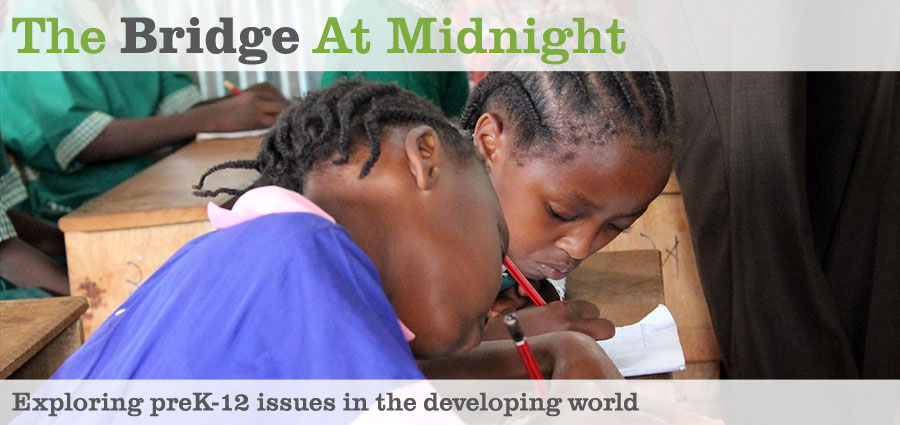Hope v. Giving Up, Part 2
Posted: November 8th, 2013 | Author: Michael Goldstein | | 1 Comment »
Earlier this week I shared Maddie Winters’ blog. By email, 3 of my favorite folks weighed in.
Chris Duffy, a former teacher at Edward Brooke charter school and producer of this show on public radio, wrote:
I think Maddie’s view is spot on. Every data analysis session I’ve participated in or sat in on has included at least a few kids whose low scores were attributed not to holes in content knowledge but “behavior issues” or “giving up.” I think the negative self-talk is the root cause there.
I’m curious how effective her modeling of hope would actually be.
It doesn’t read very differently to me than just modeling reading strategies. Maybe those few key words would have an outsize impact, but I think the negative self-talk is actually a deeper, more complex issue that requires a broader classroom culture where failure is normalized and accepted as a step towards success and a strengths-based approach to building student confidence in their skills. Seems to me that you’re more likely to feel hope if you’ve had the experience, with teacher guidance, of struggling and then succeeding than if you’re taught some phrases to say in your head.
Alex Smith, who is the Bridge director of the early childhood grades (for age 3, 4, 5), wrote:
I’ve taught lots of kids taking high-stakes test in Texas — where promotion vs. retention is at stake — and worked with lots of their teachers.
And I tend to agree with Chris on one point, that if kids track their progress and see their performance improve with effort, that is stronger than hopeful words, especially for adolescents who have heard it all — at least in the U.S.
That’s the whole, hidden reason that kids learn the times tables and place value to the millions in KIPP 5th grade summer school.
1. they need the content for everything that comes next, but also…
2. they need to realize that they can learn if they try (provided good teaching) even if they haven’t learned much in class since 2nd grade.
But I disagree on another point. In high-stakes tests, kids typically don’t perform well because they can’t, not because they won’t. And for many in class, they started to act up or give up when they realized that “I won’t” is less embarrassing than “I can’t.” And the years of that accumulate.
Chris responded:
To Alex’s second point, I certainly agree that there’s a subset of kids who consciously chooses to save face by “won’t” rather than “can’t.” There’s no question that tons of kids just lack the fundamental skills (for example, decoding or vocabulary) that are prerequisites for success on high stakes tests.
In my experience though, a lot of times a significant portion of those students actually self-assess incorrectly and when presented with problems from later on in the test could have solved them. I think that often, test taking strategies like narrowing down answers, skipping when you’re stuck, and making educated guesses can get those students much closer. They tend not to employ them because they either don’t know them or have the negative self-talk going in their heads. I think you often see this with kids who get stuck on one particular problem and spin their wheels, wasting tons of time on something that’s relatively insignificant, point-wise.
I always try to think about what strategies I actually use, to avoid preaching something that’s actually impractical. When I’ve taken high-stakes tests, I often get stuck on a confusing problem, but then I just mark it, skip it, and come back to it later. I often take educated guesses as well. But I’m only confident to use those strategies because I’ve experienced them working for me in the past.
Aungar Chatterjee, our English director, wrote:
I don’t know if the major barrier to success is ability or hope: both are probably barriers, but I don’t know to what extent for each. I do believe hope is important. Here’s what I think “operationalizing hope” looks like in a classroom:
1) Concrete success.
The power of showing a kid that x hours of work produced y gains on test/quiz/hw/grade/whatever is one of the most important first steps.
As Chris said, it’s what takes hope out of an abstract realm of axioms and actualizes it for a kid to SEE and FEEL. In my limited experience as a teacher, “management, high expectations, cheers,” none of that means anything in the long term unless you can prove to a kid that you helped them get better- they will not respect/trust you until you do that.
This allows step 2:
2) Reflection. I haven’t figured out yet how to solve this for the Bridge middle schoolers — or for any middle schoolers. Generally, I believe that if you actually take the time to analyze your mistakes and learn from them, you improve. This is what essentially people do for test prep — take practice exams, reflect on answers, identify mistakes and patterns, retake them.
The process for kids needs to be MUCH more systematized. We often say, “Write down what you learned from your mistake” …which means very little to a kid. We need a system that gets a typical kid to reflect on his growth and track progress in a meaningful way, instead of a “going through the motions” way.
Is “operationalizing hope” (for kids whose academic performance to date has been low) one of the key puzzles to solve for Bridge? I think it is…but figuring out the mega-reading puzzle (how kids, whose families can afford roughly less than 1 cent per day per class for curriculum materials, will ever have enough good stuff to read) is just as important, if not more.


[…] http://www.thebridgeatmidnight.com/2013/11/08/hope-v-giving-up-part-2/?utm_source=feedburner&utm… […]